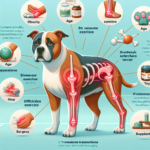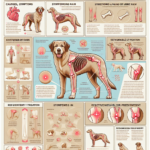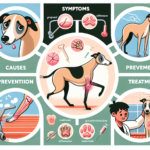German Pinscher Joint Pain: Causes, Symptoms, Prevention, and Treatment

Introduction
The German Pinscher is a medium-sized breed known for its agility, intelligence, and spirited personality. Originating from Germany, this breed has a rich history dating back to the 19th century, where it was primarily used for hunting and guarding. German Pinschers are characterized by their sleek, muscular build, short coat, and alert expression. They are highly energetic and require regular physical and mental stimulation to stay happy and healthy.
Like many breeds, German Pinschers are prone to certain health issues, with joint pain being a significant concern. Joint health is crucial for maintaining the breed’s active lifestyle and overall well-being. Understanding the causes, symptoms, prevention, and treatment of joint pain in German Pinschers can help owners ensure their pets lead a comfortable and active life.
Breed-Specific Joint Pain Risks
Genetic Predisposition
German Pinschers, like many purebred dogs, have a genetic predisposition to certain joint-related issues. Hip dysplasia, a condition where the hip joint doesn’t fit properly into the hip socket, is relatively common in this breed. Elbow dysplasia, where the elbow joint is malformed, can also occur. Both conditions can lead to arthritis and chronic pain if not addressed early.
Age-Related Risks
As German Pinschers age, the risk of developing joint pain increases. The cartilage that cushions the joints can wear down over time, leading to arthritis. Owners should be particularly vigilant as their dogs approach middle age, typically around 5-7 years old, as this is when joint issues often begin to manifest.
Activity Level and Joint Stress
German Pinschers are known for their high energy levels and love for physical activities such as running, jumping, and playing. While regular exercise is essential for their health, excessive or high-impact activities can put stress on their joints, potentially leading to injuries and long-term joint problems. It’s important to balance their activity levels to prevent undue stress on their joints.
Common Symptoms of Joint Pain in German Pinschers
General Symptoms
- Limping or favoring one leg
- Stiffness, especially after resting
- Reluctance to move, jump, or climb stairs
- Decreased activity or playfulness
- Swelling around the joints
- Whining or showing signs of discomfort when touched
Breed-Specific Symptoms
In German Pinschers, joint pain may manifest as a noticeable change in their gait or reluctance to engage in activities they previously enjoyed. Due to their high energy levels, a sudden decrease in activity or enthusiasm for play can be a significant indicator of joint pain.
When to Consult a Vet
If you notice any of the above symptoms in your German Pinscher, it’s essential to consult a veterinarian promptly. Early diagnosis and treatment can prevent further deterioration and improve your dog’s quality of life. Regular veterinary check-ups are also crucial for monitoring joint health and catching any issues early.
Preventive Measures for Joint Health
Exercise Recommendations
Regular, moderate exercise is key to maintaining joint health in German Pinschers. Activities such as walking, swimming, and controlled play can help keep their joints flexible and muscles strong without causing excessive stress. Avoid high-impact activities like jumping from heights or running on hard surfaces, which can strain their joints.
Dietary Suggestions
A balanced diet rich in essential nutrients can support joint health. Look for dog foods that contain glucosamine and chondroitin, which help maintain cartilage health. Omega-3 fatty acids, found in fish oil supplements, can also reduce inflammation and support joint function. Consult your veterinarian for specific dietary recommendations tailored to your dog’s needs.
Weight Management
Maintaining a healthy weight is crucial for reducing joint stress. Excess weight can exacerbate joint problems and lead to earlier onset of arthritis. Monitor your German Pinscher’s weight and adjust their diet and exercise routine as needed to keep them at an optimal weight.
Early Screening and Monitoring
Regular veterinary check-ups and early screening for joint issues can help catch problems before they become severe. X-rays and other diagnostic tools can identify conditions like hip or elbow dysplasia early on, allowing for timely intervention. Discuss with your vet about the best screening schedule for your German Pinscher.
Treatment Options for Joint Pain
Non-Surgical Treatments
For mild to moderate joint pain, non-surgical treatments can be effective. These may include:
- Medications: Anti-inflammatory drugs and pain relievers can help manage pain and reduce inflammation.
- Physical Therapy: Exercises and therapies designed to improve joint function and reduce pain.
- Lifestyle Adjustments: Modifying your dog’s activity levels and providing a comfortable living environment.
Surgical Options
In severe cases, surgical intervention may be necessary. Common surgical options for joint pain in German Pinschers include:
- Hip Replacement: Replacing the damaged hip joint with an artificial one.
- Arthroscopy: A minimally invasive procedure to clean out the joint and remove damaged tissue.
- Osteotomy: Cutting and realigning bones to improve joint function.
Consult with a veterinary orthopedic specialist to determine the best surgical option for your dog.
Alternative Therapies
Alternative treatments can complement traditional therapies and provide additional relief. These may include:
- Acupuncture: Using needles to stimulate specific points on the body to relieve pain.
- Hydrotherapy: Water-based exercises that reduce joint stress while improving strength and flexibility.
- Massage: Gentle massage techniques to improve circulation and reduce muscle tension around the joints.
Lifestyle and Management Tips
Daily Care Routine
A consistent daily care routine can help manage joint pain in German Pinschers. This may include:
- Regular, low-impact exercise such as walking or swimming.
- Providing a balanced diet with joint-supporting nutrients.
- Administering any prescribed medications or supplements.
- Monitoring your dog’s weight and adjusting their diet as needed.
- Regular veterinary check-ups to monitor joint health.
Modifying the Home Environment
Making your home more comfortable for a dog with joint pain can significantly improve their quality of life. Consider the following modifications:
- Using ramps or steps to help your dog access furniture or climb stairs.
- Providing orthopedic beds that offer better support for their joints.
- Ensuring food and water bowls are at a comfortable height to reduce strain.
- Keeping floors free of slippery surfaces to prevent falls.
Long-Term Management
Long-term management of joint pain involves a combination of regular veterinary care, appropriate exercise, a balanced diet, and a supportive home environment. Consistency is key to keeping your German Pinscher active and happy despite joint pain. Work closely with your veterinarian to develop a comprehensive management plan tailored to your dog’s needs.
FAQs About German Pinschers and Joint Pain
What are the early signs of joint pain in German Pinschers?
Early signs of joint pain include limping, stiffness, reluctance to move, and decreased activity levels. If you notice any of these symptoms, consult your veterinarian for a thorough examination.
Can joint pain in German Pinschers be prevented?
While genetic predispositions cannot be entirely prevented, maintaining a healthy weight, providing regular low-impact exercise, and feeding a balanced diet with joint-supporting nutrients can help reduce the risk of joint pain.
Are there specific exercises that are better for German Pinschers with joint pain?
Yes, low-impact exercises such as walking, swimming, and controlled play are ideal for German Pinschers with joint pain. Avoid high-impact activities that can strain their joints.
What dietary supplements can help with joint health in German Pinschers?
Supplements containing glucosamine, chondroitin, and omega-3 fatty acids can support joint health. Consult your veterinarian for specific recommendations based on your dog’s needs.
When should I consider surgery for my German Pinscher’s joint pain?
Surgery may be considered if non-surgical treatments are ineffective and your dog is experiencing severe pain or mobility issues. Consult with a veterinary orthopedic specialist to discuss the best surgical options for your dog.
Conclusion
Joint pain is a common concern for German Pinschers, but with proper care and attention, it can be managed effectively. By understanding the causes, symptoms, prevention, and treatment options, owners can help their dogs lead active and comfortable lives. Regular veterinary check-ups, a balanced diet, appropriate exercise, and a supportive home environment are key to maintaining joint health in German Pinschers. Taking proactive measures and consulting with your veterinarian can ensure your dog’s well-being and longevity.




